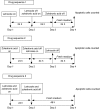Combined effects of the bisphosphonate, zoledronic acid and the aromatase inhibitor letrozole on breast cancer cells in vitro: evidence of synergistic interaction
- PMID: 20160726
- PMCID: PMC2844031
- DOI: 10.1038/sj.bjc.6605579
Combined effects of the bisphosphonate, zoledronic acid and the aromatase inhibitor letrozole on breast cancer cells in vitro: evidence of synergistic interaction
Abstract
Background: Aromatase inhibitors are widely used in the treatment of oestrogen receptor-positive post-menopausal breast cancer. These patients may also be receiving the bisphosphonate, zoledronic acid (ZA) to prevent bone loss or reduce skeletal morbidity in the setting of advanced disease. The potential biological interaction of these two drugs in breast cancer has not been assessed.
Methods: Aromatase-expressing breast cancer cells were treated with letrozole and ZA either simultaneously or in sequence, and the resulting apoptosis was assessed by staining with Hoechst 33342 and propidium iodide and examined using a fluorescent inverted Leica DMIRB microscope and a UV filter.
Results: We found that letrozole and ZA induce levels of apoptosis in breast cancer cells in vitro that are significantly greater compared with treatment with each drug alone. However, this potentially, synergistic relationship is drug-sequence dependent, occurring only when cells are treated with letrozole, followed by ZA. The converse sequence, or administering drugs simultaneously, induces levels of apoptosis no greater than each drug alone.
Conclusion: Owing to the enhanced anti-tumour efficacy of sequential drug administration, our findings may indicate that, for post-menopausal women who require treatment with letrozole, ZA should also be considered.
Figures








Similar articles
-
Zoledronic acid inhibits aromatase activity and phosphorylation: potential mechanism for additive zoledronic acid and letrozole drug interaction.J Steroid Biochem Mol Biol. 2012 Nov;132(3-5):195-202. doi: 10.1016/j.jsbmb.2012.05.008. Epub 2012 Jun 1. J Steroid Biochem Mol Biol. 2012. PMID: 22659283 Free PMC article.
-
Synergistic suppression of human breast cancer cells by combination of plumbagin and zoledronic acid In vitro.Acta Pharmacol Sin. 2015 Sep;36(9):1085-98. doi: 10.1038/aps.2015.42. Epub 2015 Aug 3. Acta Pharmacol Sin. 2015. PMID: 26235741 Free PMC article.
-
The aromatase inhibitor letrozole and inhibitors of insulin-like growth factor I receptor synergistically induce apoptosis in in vitro models of estrogen-dependent breast cancer.Breast Cancer Res. 2008;10(4):R56. doi: 10.1186/bcr2113. Epub 2008 Jul 8. Breast Cancer Res. 2008. PMID: 18611244 Free PMC article.
-
Improving bone health in patients with early breast cancer by adding bisphosphonates to letrozole: the Z-ZO-E-ZO-FAST program.Breast. 2006 Feb;15 Suppl 1:S30-40. doi: 10.1016/j.breast.2006.01.005. Breast. 2006. PMID: 16500238 Review.
-
Optimizing bisphosphonate therapy in patients with breast cancer on endocrine therapy.Semin Oncol. 2004 Dec;31(6 Suppl 12):23-30. doi: 10.1053/j.seminoncol.2004.09.023. Semin Oncol. 2004. PMID: 15719598 Review.
Cited by
-
FDPS cooperates with PTEN loss to promote prostate cancer progression through modulation of small GTPases/AKT axis.Oncogene. 2019 Jun;38(26):5265-5280. doi: 10.1038/s41388-019-0791-9. Epub 2019 Mar 26. Oncogene. 2019. PMID: 30914801 Free PMC article.
-
Breast cancer outcome in relation to bone mineral density and bisphosphonate use: a sub-study of the DATA trial.Breast Cancer Res Treat. 2020 Apr;180(3):675-685. doi: 10.1007/s10549-020-05567-9. Epub 2020 Mar 2. Breast Cancer Res Treat. 2020. PMID: 32124136 Free PMC article. Clinical Trial.
-
Randomized Controlled Trial of Zoledronic Acid plus Chemotherapy versus Chemotherapy Alone as Neoadjuvant Treatment of HER2-Negative Primary Breast Cancer (JONIE Study).PLoS One. 2015 Dec 3;10(12):e0143643. doi: 10.1371/journal.pone.0143643. eCollection 2015. PLoS One. 2015. PMID: 26633806 Free PMC article. Clinical Trial.
-
Probenecid as a sensitizer of bisphosphonate-mediated effects in breast cancer cells.Mol Cancer. 2014 Dec 11;13:265. doi: 10.1186/1476-4598-13-265. Mol Cancer. 2014. PMID: 25496233 Free PMC article.
-
Anti-GD2-ch14.18/CHO coated nanoparticles mediate glioblastoma (GBM)-specific delivery of the aromatase inhibitor, Letrozole, reducing proliferation, migration and chemoresistance in patient-derived GBM tumor cells.Oncotarget. 2017 Mar 7;8(10):16605-16620. doi: 10.18632/oncotarget.15073. Oncotarget. 2017. PMID: 28178667 Free PMC article.
References
-
- Amin D, Cornell SA, Gustafson SK, Needle SJ, Ullrich JW, Bilder GE, Perrone MH (1992) Bisphosphonates used for the treatment of bone disorders inhibit squalene synthase and cholesterol biosynthesis. J Lipid Res 33: 1657–1663 - PubMed
-
- Benford HL, McGowan NW, Helfrich MH, Nuttall ME, Rogers MJ (2001) Visualization of bisphosphonate-induced caspase-3 activity in apoptotic osteoclasts in vitro. Bone 28: 465–473 - PubMed
-
- Chen T, Berenson J, Vescio R, Swift R, Gilchick A, Goodin S, LoRusso P, Ma P, Ravera C, Deckert F, Schran H, Seaman J, Skerjanec A (2002) Pharmacokinetics and pharmacodynamics of zoledronic acid in cancer patients with bone metastases. J Clin Pharmacol 42: 1228–1236 - PubMed
-
- Dunford JE, Thompson K, Coxon FP, Luckman SP, Hahn FM, Poulter CD, Ebetino FH, Rogers MJ (2001) Structure-activity relationships for inhibition of farnesyl diphosphate synthase in vitro and inhibition of bone resorption in vivo by nitrogen-containing bisphosphonates. J Pharmacol Exp Ther 296: 235–242 - PubMed
MeSH terms
Substances
LinkOut - more resources
Full Text Sources
Medical

